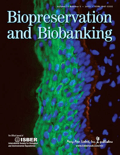
Biopreservation and Biobanking
Scope & Guideline
Pioneering Techniques for Sustainable Biobanking
Introduction
Aims and Scopes
- Cryopreservation Techniques:
The journal emphasizes innovative cryopreservation methods, including the use of various cryoprotectants and freezing protocols to enhance the viability and functionality of preserved biological materials. - Biospecimen Quality and Integrity:
A core focus is the assessment and improvement of biospecimen quality, including the effects of preanalytical variables on sample integrity, which is crucial for reproducibility in research. - Ethical, Legal, and Social Issues (ELSI):
The journal explores the ethical implications and regulatory frameworks surrounding biobanking, including informed consent processes and public perceptions of biobanking practices. - Technological Innovations in Biobanking:
Research on the integration of new technologies, such as automated systems and informatics tools, to streamline biobanking processes and enhance data management is a significant theme. - Diversity in Biobanking Practices:
The journal highlights the importance of equity, diversity, and inclusion in biobanking, advocating for practices that consider diverse populations and their unique needs. - Applications in Translational Research:
There is a strong emphasis on how biobanked samples are utilized in translational research, particularly in fields like cancer research, reproductive health, and genetic studies.
Trending and Emerging
- Sustainable Biobanking Practices:
Recent publications are increasingly addressing the environmental impact of biobanking, focusing on sustainable practices that reduce carbon footprints, such as energy-efficient storage solutions. - Liquid Biopsy and Novel Biospecimen Types:
There is a growing emphasis on the use of liquid biopsies and other innovative biospecimen types, which are becoming critical for non-invasive research applications, particularly in cancer diagnostics. - Data Sharing and Accessibility:
Emerging themes include the importance of data sharing frameworks and open-access initiatives that facilitate broader collaboration and enhance the utility of biobanked samples. - Public Engagement and Trust in Biobanking:
The journal is increasingly focusing on how public perception and engagement can influence biobanking practices, with studies exploring community attitudes towards biospecimen donation and consent. - Integration of Artificial Intelligence in Biobanking:
There is a noticeable trend towards leveraging artificial intelligence and machine learning to enhance biobank operations, from sample processing to data analysis, reflecting a shift towards more sophisticated methodologies.
Declining or Waning
- Traditional Biobanking Methods:
As the journal increasingly focuses on innovative techniques and technological advancements, traditional methods of biobanking, such as basic storage protocols without the integration of new technologies, are receiving less attention. - General Reviews on Biobanking:
There has been a noticeable decline in general review articles that cover broad overviews of biobanking practices, as the journal shifts towards more specific studies with detailed methodologies and results. - Niche Applications of Biobanking:
Research focusing on very niche applications of biobanking, such as specific animal species or localized biobanking initiatives, appears to be decreasing, possibly due to a shift towards more broadly applicable findings. - Biobanking for Rare Diseases:
While still relevant, the frequency of publications focused solely on biobanking for rare diseases has diminished, possibly reflecting a broader trend of integrating these topics into more general biobanking discussions.
Similar Journals

BIOTECHNOLOGY LAW REPORT
Advancing Understanding of Biotech LawBIOTECHNOLOGY LAW REPORT, published by MARY ANN LIEBERT, INC, serves as a pivotal platform for professionals and researchers engaged in the intersection of biotechnology and law. This esteemed journal, with ISSN 0730-031X and E-ISSN 1557-8704, provides critical insights into legal issues and regulatory developments surrounding biotechnological innovations. Covering a diverse range of topics from intellectual property rights to environmental law, the journal aims to foster informed dialogue and policy advancements in a rapidly evolving field. Although it currently stands in the Q4 category for both Biotechnology and Management, Monitoring, Policy and Law, the relevance of its content persists alongside its significant contributions from industry experts and academics. Published in the United States, the journal is committed to offering comprehensive coverage of pertinent themes, despite limited open access options. As it converges its publication years towards the future, BIOTECHNOLOGY LAW REPORT remains crucial for those navigating the complexities of biotechnology legislation and its global implications.
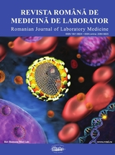
Revista Romana de Medicina de Laborator
Exploring Breakthroughs in Biochemistry and BeyondRevista Romana de Medicina de Laborator is a prominent open-access journal published by SCIENDO, dedicated to the field of medical laboratory technology and biochemistry. Since its inception, this journal has been a vital platform for disseminating research findings and advancements in laboratory medicine. With an ISSN of 1841-6624 and E-ISSN 2284-5623, it has served the academic community since 2008 and has embraced an open-access model since 2013, ensuring that valuable research is accessible to all. While it features niche rankings in Scopus for areas such as Medical Laboratory Technology and Clinical Biochemistry, it consistently strives to engage researchers, professionals, and students. Its rich collection of articles highlights innovative techniques and methodologies, supporting the ongoing development of laboratory practices. Although its coverage in Scopus has been discontinued, the journal continues to publish high-quality studies that contribute significantly to the field, fostering knowledge exchange essential for advancing medical science.

CELL AND TISSUE BANKING
Pioneering research in cell biology and tissue sustainability.CELL AND TISSUE BANKING, published by Springer, is a prominent journal dedicated to advancing the fields of biomaterials, biomedical engineering, cell biology, and transplantation. With its ISSN 1389-9333 and E-ISSN 1573-6814, the journal plays a crucial role in disseminating high-quality research from its inception in 2000 to its ongoing contributions through 2024. Situated in the Netherlands, it boasts a respectable 2023 impact factor with notable quartile rankings, positioning it within the Q3 category for biomaterials, biomedical engineering, and transplantation, and Q4 for cell biology. Furthermore, its Scopus rankings underscore its relevance and influence, particularly in the fields of medicine and engineering. Although it does not currently offer open access options, the journal remains a vital resource for researchers, professionals, and students alike, fostering innovation and knowledge transfer in the critical areas of cell and tissue sustainability.
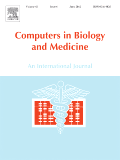
COMPUTERS IN BIOLOGY AND MEDICINE
Exploring the Frontiers of Health Informatics and Computational BiologyCOMPUTERS IN BIOLOGY AND MEDICINE is a prestigious academic journal published by Pergamon-Elsevier Science Ltd, dedicated to advancing the fields of Computer Science Applications and Health Informatics. With an impressive impact factor and ranking within the Q1 quartile for both categories, this journal plays a crucial role in disseminating high-quality research findings that influence cutting-edge developments at the intersection of computing and healthcare. Covering a broad range of topics from computational biology to medical informatics, it serves as a vital resource for researchers, professionals, and students striving to harness technology for medical advancements. The journal has been publishing since 1970 and continues to evolve, incorporating the latest trends and innovations in the field, thereby ensuring that it remains a key contributor to scientific inquiry and knowledge. With accessible content and a global reach, COMPUTERS IN BIOLOGY AND MEDICINE invites submissions that elevate the understanding and application of computational methods in biological and medical contexts.

BioTech
Showcasing Breakthroughs in Applied Microbiology and BeyondBioTech is a forward-thinking academic journal published by MDPI, specializing in the dynamic fields of applied microbiology, biotechnology, biochemistry, bioengineering, and biomedical engineering. Established for promoting impactful research from 2021 to 2024, this journal aims to bridge the gap between laboratory findings and practical applications, serving as a vital resource for researchers, practitioners, and students alike. With its Open Access model, BioTech ensures that groundbreaking innovations are freely available to the global community, fostering collaboration and knowledge transfer across disciplines. In the 2023 rankings, BioTech holds a strong position in Q2 and Q3 quartiles across various categories, reflecting its commitment to high-quality research output. Being indexed in renowned databases, the journal enhances its visibility and reach, making it a preferred platform for sharing transformative ideas and discoveries in biotechnology and related domains. Set against the backdrop of Switzerland’s thriving research environment, BioTech is poised to become an essential resource in the rapidly evolving landscape of life sciences.

JOURNAL OF ASSISTED REPRODUCTION AND GENETICS
Advancing the Frontiers of Reproductive ScienceThe Journal of Assisted Reproduction and Genetics, published by Springer/Plenum Publishers, serves as a pivotal platform for innovative research and advancements in the fields of reproductive medicine, genetics, and developmental biology. With an impact factor that positions it within the upper echelon of its categories—including Q1 rankings in Obstetrics and Gynecology and Reproductive Medicine—this journal plays a critical role in disseminating high-quality, peer-reviewed studies that significantly influence clinical practices and research directions. Renowned for its commitment to enhancing understanding in areas such as assisted reproductive technologies, genetic screening, and reproductive health, the journal attracts contributions from leading experts worldwide. With a broad scope encompassing original research, case studies, and comprehensive reviews, the Journal of Assisted Reproduction and Genetics continues to be an essential resource for researchers, healthcare professionals, and students dedicated to the advancement of reproductive sciences.

MICROSCOPY AND MICROANALYSIS
Illuminating the Future of Microscopic ScienceMICROSCOPY AND MICROANALYSIS is a prestigious academic journal published by Oxford University Press, specializing in the interdisciplinary fields of microscopy and microanalysis. With an ISSN of 1431-9276 and an E-ISSN of 1435-8115, this journal serves as a vital platform for the dissemination of high-quality research findings, innovative methodologies, and advancements in instrumentation techniques from its inception in 1995 to its ongoing contributions projected to 2024. As a Q3 ranked journal in the category of Instrumentation, it plays a crucial role in shaping the future of microscopy by providing researchers, professionals, and students with insights into cutting-edge technologies and applications. Although it does not currently offer open access, the journal remains committed to the academic community by maintaining rigorous peer-review standards and producing scholarly articles that are essential for advancing the understanding of materials at microscopic levels. By bridging the gap between theory and practical application, MICROSCOPY AND MICROANALYSIS is an indispensable resource for those involved in these dynamic scientific fields.
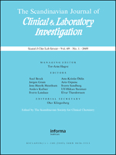
SCANDINAVIAN JOURNAL OF CLINICAL & LABORATORY INVESTIGATION
Elevating standards in health science investigations.The Scandinavian Journal of Clinical & Laboratory Investigation is a premier publication in the fields of clinical biochemistry and laboratory medicine, published by Taylor & Francis Ltd in the United Kingdom. With an ISSN of 0036-5513 and E-ISSN 1502-7686, this journal has been a vital source of scholarly articles since its inception in 1949, and is set to celebrate over seventy-five years of contributing to scientific knowledge in 2024. Ranked in the Q2 category for both Clinical Biochemistry and Medicine (Miscellaneous), it holds a robust position within the Scopus rankings, with a commendable rank of 77/117 in its discipline. The journal is dedicated to advancing research by offering a platform for high-quality studies that explore the development and application of clinical and laboratory investigations, making it essential reading for researchers, practitioners, and students interested in the latest advances and methodologies in the field. Although it does not currently offer Open Access, a wealth of valuable research insights awaits readers within its pages, highlighting its crucial role in fostering communication and innovation in clinical sciences.

Journal of Spectroscopy
Elevating Spectroscopy: Where Knowledge Meets InnovationJournal of Spectroscopy, published by HINDAWI LTD since 2009, is a renowned Open Access journal based in Egypt that serves as a valuable platform for the dissemination of cutting-edge research in the fields of analytical chemistry, atomic and molecular physics, and optics. With the unique ISSN 2314-4920 and E-ISSN 2314-4939, this journal aims to facilitate collaboration and knowledge exchange among researchers, professionals, and students by providing unrestricted access to essential findings and advancements. As of 2023, it holds a Q3 ranking in both Analytical Chemistry and Atomic and Molecular Physics, and a Q4 ranking in Spectroscopy, indicating its growing influence and relevance within the academic community. The journal also maintains a Scopus rank of #126 in Atomic and Molecular Physics and #53 in Spectroscopy, showcasing its commitment to high-quality scholarly content. With a converged timeline from 2013 to 2024, the Journal of Spectroscopy is positioned as a pivotal resource for the latest discoveries and innovative applications in spectroscopy-related studies.
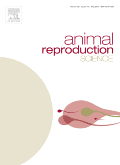
ANIMAL REPRODUCTION SCIENCE
Navigating the Complexities of Animal DevelopmentANIMAL REPRODUCTION SCIENCE, published by Elsevier, is a leading journal dedicated to the field of animal reproduction and developmental biology. With an ISSN of 0378-4320 and an E-ISSN of 1873-2232, it serves as a vital resource for researchers, professionals, and students interested in advancing their understanding of reproductive mechanisms across various species. The journal has been recognized for its high-quality contributions, achieving a Q1 ranking in Animal Science and Zoology and showcasing its significant impact in the areas of Endocrinology and Veterinary Medicine as per the 2023 category quartiles. Covering a wide range of topics from reproductive physiology to genetic implications, this journal not only highlights innovative research but also fosters interdisciplinary dialogue in the rapidly evolving world of animal science. Though not currently offering open access, it remains a crucial platform for disseminating pivotal research findings from across the globe. With its rich history dating back to 1936, ANIMAL REPRODUCTION SCIENCE continues to drive excellence in animal reproduction studies, positioning itself at the forefront of the field, and solidifying its relevance in both science and industry.